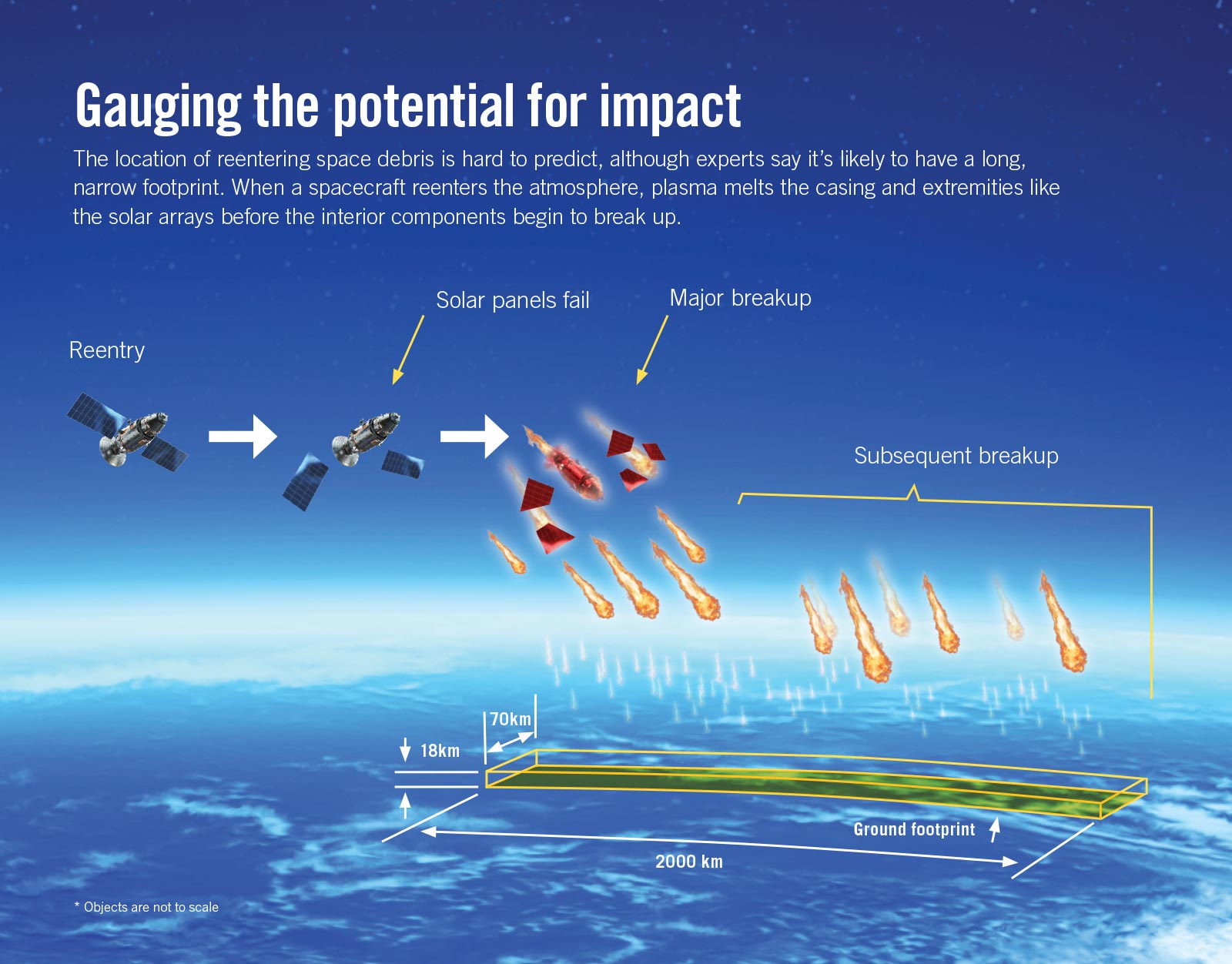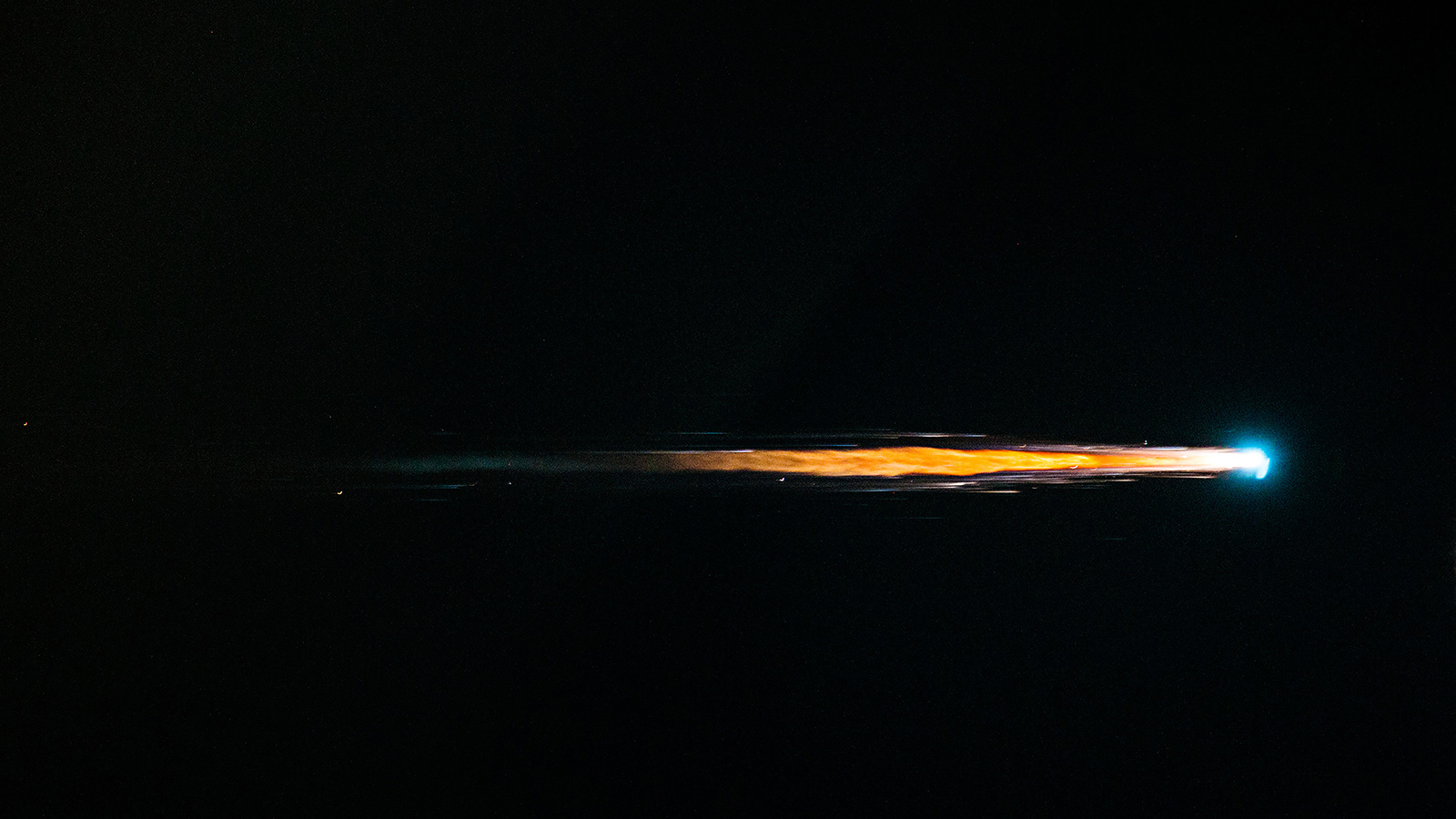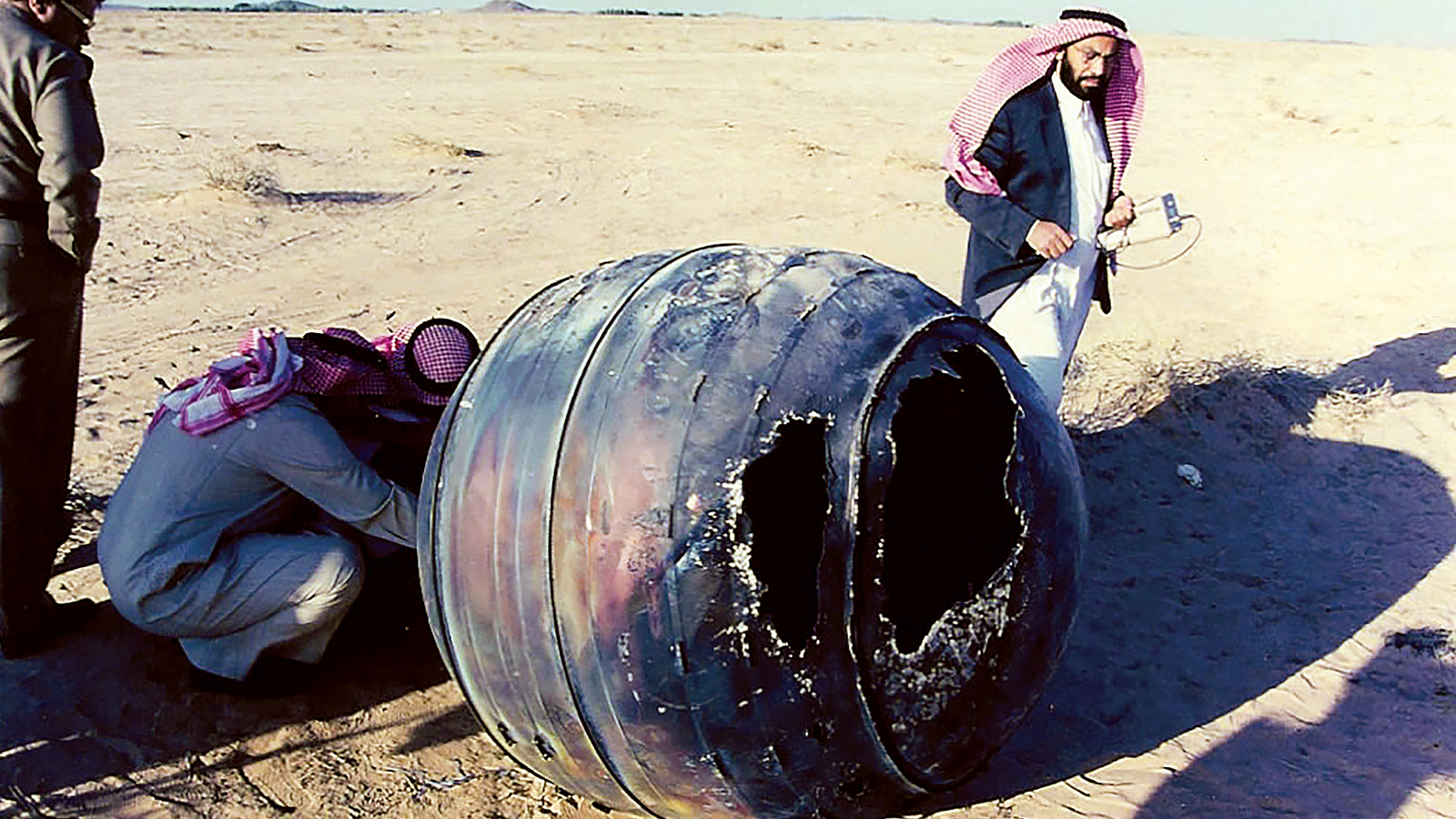Dodging debris
By Paul Marks|July/August 2021
When each of the thousands of satellites in tomorrow’s immense orbital internet swarms fall back to Earth, as they inevitably must, some of the debris might not burn up entirely before reaching the altitudes plied by airlines and militaries. Space safety engineers tell Paul Marks that a serious collision risk is brewing — and a vigorous search for solutions is necessary, right now.
★ Click at right to open this story’s Knowledge Guide entries.
★ Click star at right to open Knowledge Guide.
On Christmas Day 1996, a mysterious object, probably no bigger than a marble, smacked into the cockpit windshield of a Boeing 757 as it cruised at 31,500 feet en route from Beijing to Wuhan. The impact cracked the outer pane of the three-ply windshield, Reuters reported, threatening a cockpit depressurization and forcing the crew of the China Southern Airlines-operated jet to return to Beijing’s Capital International Airport for an emergency landing.
“That report could well have been describing a fragment from a piece of a reentered space object,” says William Ailor, a technical fellow at the Aerospace Corp.’s Center for Orbital and Reentry Debris Studies in California. “It shows that although a small fragment might not necessarily take down an aircraft or be fatal, it can still lead to a crew taking emergency action.”
That windshield impact was rare, perhaps even unprecedented, in the annals of air travel, but spaceflight observers, Ailor among them, fear aviation’s luck against satellite debris may be in danger of running out. The reason? The vastly increased numbers of spacecraft that will in the future need to be de-orbited given the growth of megaconstellations — immense swarms of satellites now being deployed in low-Earth orbit mainly to provide low-latency connections to the internet.
Operators should de-orbit each satellite at the end of its life safely over the ocean and away from air routes, but the sheer number of spacecraft leaves room for uncontrolled reentries, perhaps due to failures or impacts with fragments from orbital collisions.
Megaconstellation satellite builders, with the encouragement of the U.S. Federal Communications Commission, are designing their spacecraft for demise in the belief that choosing the right materials can make them burn up completely on reentry, even if they do not reenter where planned. Amazon’s Kuiper division, which plans to orbit 3,200 satellites, would not discuss plans for demisability, except to say that it complies fully with FCC rules on de-orbiting, although right now, the FCC encourages but does not require demisability. SpaceX, which plans the largest constellation at 42,000, two years ago told the FCC that the latest Starlink satellites are fully demisable.
Some experts remain skeptical that a whole satellite is in fact capable of being wholly incinerated. So it is time, these space safety specialists argue, for the aerospace industry to begin looking into developing tools that would warn pilots of impending uncontrolled reentries so they can take evasive action.
Massively boosting the number of spacecraft in orbit by many tens of thousands means that the number de-orbited at the end of their circa-five-year lives will go up too. Currently there are 4,300 working satellites on orbit, out of the 7,200 launched since the dawn of the Space Age. In addition to SpaceX’s Starlinks and the Kuiper satellites, the state-owned China Satellite Network Group plans 13,000; OneWeb, based in London, plans to orbit 650. Firms including Samsung, Telesat and Viasat also are planning such networks.
Until now, most concerns about these megaconstellations have centered on the risk of orbital collisions sparking a Kessler syndrome event — a cascade of collisions and fragmentations that could pollute near-Earth space for decades. Astronomers have also complained that the swarms can be visible to their large, sensitive ground-based astronomical telescopes.
Bringing the risk to Earth
Now, if the promised swelling of the orbital population comes to pass, the mass of satellites being de-orbited could grow about 30 times, from around 100 tons to as much as 3,200 tons per year, the Aerospace Corp. calculated in 2020. This would increase the risk to aviation, provided not everyone’s satellites turn out to be fully demisable.
This stark warning was sounded by Michael Kezirian, an astronautical engineer at the University of Southern California, in the March 2021 edition of the peer-reviewed Journal of Space Safety Engineering — the technical periodical for the International Association for the Advancement of Space Safety.
In an extended editorial, “It Is Time To Implement Mitigation Strategies To Protect the Airspace From Space Debris,” Kezirian, the journal’s founding editor-in-chief, notes that the American Astronomical Society has predicted that in the next five years alone megaconstellations will multiply the number of objects accumulated in orbit by fivefold — and that those in turn will de-orbit at the end of their life, increasing the rate of reentries.
“Given the continued growth of new operational spacecraft, combined with the introduction of megaconstellations, the likelihood of a Black Swan event in the airspace is becoming more likely,” Kezirian writes. A Black Swan event is one that is extremely rare, with causes beyond the design and risk considerations engineers ordinarily cater for, and with severe consequences, such as the loss of an airliner.
This is more likely because the increase in de-orbiting frequency would heighten the chances of the kind of reentries nobody wants to see: unpredictable, uncontrolled ones, perhaps due to some kind of station-keeping failure on orbit, or a collision with a large piece of space debris, such as one of the most dangerous pieces of junk on orbit. An example is the European Space Agency’s now-derelict 8-ton satellite, Envisat, which lost power in 2012 and has been tumbling out of control in LEO ever since.
Under United Nations guidelines, however, most modern satellites, including those in the megaconstellations, will undergo a controlled de-orbit by their operators into the atmosphere over a remote area like the South Pacific Ocean Uninhabited Area. As a reentering object plows into the atmosphere at 27,000 kph, intense friction with air molecules heats the air to an incandescence, creating an ionized plasma at 1477 degrees Celsius — which first melts slim extremities like the solar panels and the casing, and then the components the casing has been shielding, resulting in a sequence of catastrophic breakups.
“They look like a meteor coming into the atmosphere, a very bright fireball, which then breaks apart and creates a shower of particles. After a while all that stuff slows down, and at around 100,000 feet it all falls straight down and it’s just a bunch of cooling fragments at that point, not something that is terribly visible,” Ailor says. Owing to its speed, this cloud of fragments falls in a footprint some 2,000 kilometers long and 70 km wide, falling pretty much vertically, depending on the strength of crosswinds, into the 60,000-foot-deep (18 km) airspace volume plied by airplanes, such as where that Chinese 757 was flying.
How much of the satellite survives? In 2008, Ailor, working with Paul Wilde of the FAA’s Office of Commercial Space Transportation, estimated that of the 70 space objects with masses of 800 kilograms or more that fell to Earth that year, between 10% and 40% of the mass of each probably survived the fall into the airspace — with as many as 300 fragments that could be lethal to an aircraft. That was based on radar data and tests with a device called a Reentry Breakup Recorder, one of which was fixed to a European Automated Transfer Vehicle and another to a Japan Aerospace Exploration Agency H-II Transfer Vehicle before they de-orbited after leaving the International Space Station.
Risks increasing
Megaconstellations, however, consist of less massive satellites: The Starlinks come in at 250 kg, for instance, and OneWeb’s at 150 kg. So just what is the risk that surviving chunks of those lighter spacecraft will hit an airplane once megaconstellations are swirling around the planet in multiple orbital shells and inclinations? Working it out is tough, as operators keep upping their numbers, but in February 2020, Ailor revealed some risk calculations, projecting the risk for 2030 when, at the time he performed his calculations, 16,000 satellites of 150 kg or larger were expected to be in LEO.
In a paper delivered at the February 2020 Science and Technical Meeting of the U.N. Committee on the Peaceful Uses of Outer Space, Ailor calculated that by 2030 the probability of casualties on the ground will rise to 0.1 per year. In other words, one human injury or death on Earth’s surface can be expected every 10 years. And the probability of a fragment hitting an airplane in the airspace is 0.001/year, equal to one debris strike every 1,000 years, compared to a risk of once every 50,000 years for the current number of satellites.
With an average of about 300 people on a single airliner, the maximum yearly casualty expectation rises to 0.3 per year. “If a large piece of space debris hits an airplane in flight, it is almost certain to be fatal to everyone on board,” he says.
“The thing with aircraft strikes is that something has to hit the aircraft before you have a human casualty. And if debris hits the aircraft, you then have to ask: How many people are on the aircraft that would be affected by that? So that’s where we get the larger number from,” Ailor says.
But here’s the thing: After Ailor wrote the 2020 paper, new applications arrived at the FCC, including one bringing the Starlink plan to 42,000 satellites, and to about 55,000 satellites over 150 kg overall. So, the risk will likely be even higher in 2030 than Ailor’s estimate. Factor in growth in aviation as it bounces back after the covid-19 pandemic, and the risk could be higher still.
“The progress of new space, with increased numbers of users of the orbital space, has significantly increased the likelihood of the loss of aircraft from reentering space debris,” Kezirian writes.
So I called Kezirian to see how he thinks aviation should respond to this heightened threat. He wants a clutch of emerging technologies to be harnessed to provide aircrew with inflight alerts that warn of impending uncontrolled reentries that threaten their airliners. “To alert aircraft you need to know when the debris is coming in, at what angle and at what time. Currently Space-Track [a service of the U.S. Space Surveillance Network] tracks the debris, but it does not tell you how likely a reentering piece is to hit a particular aircraft.
“And predicting the reentry is not trivial: A one-minute uncertainty over a reentry time means many hundreds of miles uncertainty over where it breaks up,” Kezirian says.
So he believes developing such tools will involve enhancing space traffic management software to track the debris and predict its reentry point, plus using spacecraft breakup analysis tools to predict the debris footprint in the airspace, and creating a way to transmit and display warning predictions in a timely fashion to the crew.
This is not entirely a new idea, he says. The need to protect aviation from uncontrolled, debris-shedding reentries has its roots in a controlled reentry that went horribly wrong — one of crewed spaceflight’s greatest tragedies: the space shuttle Columbia disaster.
On its reentry after a science mission on Feb. 1, 2003, hot, incandescent plasma invaded Columbia’s left wing, whose reinforced carbon-carbon leading edge had, unknown to the crew and NASA, been holed by a briefcase-sized chunk of insulating foam shed by the shuttle’s external tank during launch. As the orbiter’s internal structure melted, it broke apart at an altitude of 37 miles on its way back to Florida, killing its crew of seven and shedding debris into West Texas, Arkansas and Louisiana.
What is less well known, however, is that no fewer than nine airliners flew through what Kezirian calls the “curtain” of debris the crippled spacecraft was shedding. Miraculously, none of those airplanes was hit. “For 40 minutes the debris objects came down and there was no mechanism in place to let [mission control] warn airlines of the risk,” Kezirian says. That close call for those nine airliners shocked the FAA, prompting it to establish procedures designed to let it redirect air traffic around spacecraft debris in any future de-orbiting tragedy.
Issuing real-time alerts
What’s really needed, the International Association for the Advancement of Space Safety said in a 2014 position paper, are real-time tools that can both track space object reentries and provide warnings to air traffic control and pilots when an uncontrolled reentry is likely. Called the Aviation Debris and Meteoroids Integrated Risk Evaluation white paper, such technology is high on the association’s wish list, says Kezirian.
While the technology to do this tracking was not available in 2014, it is starting to become available now, he says, through the emergence in the new space economy of commercial space traffic management companies. Such firms include NORSS in the United Kingdom, LeoLabs and ExoAnalytic in the U.S., Okapi Orbits in Germany and Share My Space in France. As these firms improve their capabilities with new ground-based cameras, telescopes and radars, and perhaps future space-based infrared, look-down sensing satellites, he believes they will be able to predict reentries “not tomorrow, but soon.”
He envisions such data being fed to a regular cockpit route planning and weather alerting app like ForeFlight, which is owned by Boeing. He’s so confident it will work that he’s just filed a U.S. patent on a way of doing this efficiently.
The European Space Agency and the European Union’s research arm have investigated a different approach to pilot reentry alerts, in which a device attached to every satellite before it is launched would sense the heat of reentry and broadcast the object’s position and likely debris footprint to aircraft. But as this involves adding fuel-consuming mass to a satellite, it is an idea that might not be attractive to constellation operators, as carrying spare mass would reduce a satellite’s service lifetime.
Any pilot alerting system will also need to be programmed with information on how different types of space objects break up, too, so that it knows which parts — like pumps, tanks, solar panels and thrusters — get torn off and survive the heat and which parts evaporate, and which parts produce a cloud of particles, perhaps, that drop into aviation airspace below 60,000 feet. But this may turn out to be difficult in the era of megaconstellations — because operators adopting demisable spacecraft insist the whole spacecraft burns up.
In this emerging technique, dense metallic components and tough materials like silicon carbide are replaced in the design and manufacturing steps with light, skinny alternatives that are supposed to vaporize as the structure succumbs to the extreme heat of reentry. SpaceX, which declined to discuss its demisable approach with me, told the FCC in 2019 that no part of its latest Starlink satellites “will survive atmospheric reentry, reducing casualty risk to zero.”
But this technique is new, and some experts express frustration over the great faith being put into a method they view as unproven. “People need to wake up a little bit about design-for-demise. It’s a hypothesis; it is not a proven technology,” says Tommaso Sgobba, executive director of the IAASS, and former head of the Independent Safety Office at the European Space Agency’s ESTEC research center in Nordwijk, Netherlands.
Is there any way to get that evidence? Maybe. “It’s really hard to say whether or not you can actually get something to be 100% demisable on reentry. The only way you can really test it is to use a high Mach number plasma wind tunnel, which simulates reentry conditions,” says Hugh Lewis, a specialist in reentry physics and space debris modelling at the University of Southhampton in the U.K. Even then, Sgobba cautions that the conditions in plasma chambers might not always reflect the realities of reentry.
Kezirian, a specialist in spacecraft composite overwrapped pressure vessel design, knows just how hard it is to make spacecraft tanks that are strong enough for their job but also demisable on reentry. There are other parts of a spacecraft he believes design-for-demise proponents will have trouble burning up, including thrusters, batteries and reaction wheels, which are often made of heavy metals or composites. Asked to comment on any design-for-demise progress they have made, SpaceX and Amazon’s Kuiper declined to comment.
Whether all of a spacecraft demises or not, another risk of the approach was described in a paper in the May issue of Nature Scientific Reports, “Satellite Megaconstellations Create Risks in Low Earth Orbit, the Atmosphere and on Earth.” Physicist Aaron Boley at the University of British Columbia in Vancouver suggested that regularly vaporizing Starlink satellites might deposit more aluminum particles in the upper atmosphere than meteoroids do now. This could adversely affect radio communication with spacecraft, says Kezirian, and perhaps radio astronomy too. There are even questions brewing over whether this metallic layer could act like atmospheric kitchen foil — trapping heat and so contributing to global warming.
What’s absolutely certain, however, is that more and more spacecraft are going into orbit — across all applications, not just the orbital internet — and so more and more will have to de-orbit, increasing the likelihood of uncontrolled reentries due to failures or collisions that might then impact passenger-packed airliners. So Kezirian remains insistent: “My sense is that protection measures like those I’m suggesting are not very expensive; it’d be a small cost to a trillion-dollar industry. There is a lot that can be done to mitigate a pretty horrendous risk,” he says.
Related Topics
Communications satellites











